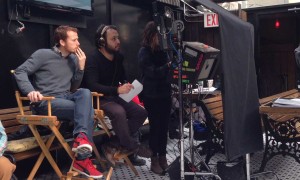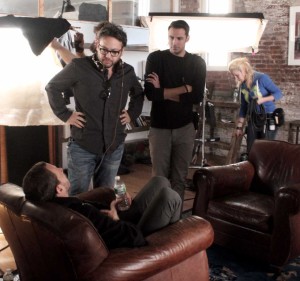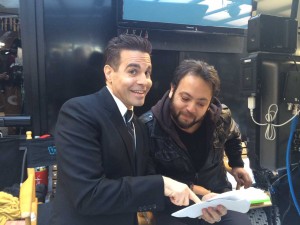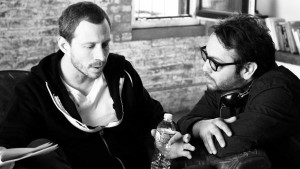
For his first feature as director, filmmaker Mel Rodriguez III made a bold decision: he was going to film his low-budget outing, a modern twist on the romantic comedy, on the streets of New York City. Citing the movies of Woody Allen and Noah Baumbach, Rodriquez aimed to shoot a film in the tradition of the directors he admires.
“I love these movies shot in New York,” said Rodriquez, who also wrote and edited the film, In Stereo. “I wrote the script as an idea that I would make it my third movie – my Punch Drunk Love. This would be that artsy grace note of a movie, a little aside. Not that I’m preplanning my career that way, but I would like to follow the careers of certain filmmakers.”
A longtime editor and director of numerous short projects, Rodriguez spent due time attempting to create his first feature. “I was so frustrated for years not being able to get anything together,” he said, citing the difficulty of directors launching their first full-length project. Eventually, he circled back to In Stereo, though it was ideally slated for coming later in his career. “I needed to shoot something as my first film,” he said, noting that In Stereo was made on a small budget without any significant cast-and-crew names.
 After much ado, and with a small amount of money, Rodriguez finally committed to make In Stereo. In pre-production, shooting it in New York seemed like a long shot. “It never occurred to me to actually ask,” he quipped about the dream location that seemingly comes with decisive production problems. “We were going to make it in L.A. The producers and I started bouncing it around. We would be such an under-the-radar movie, I didn’t think we would get noticed.”
After much ado, and with a small amount of money, Rodriguez finally committed to make In Stereo. In pre-production, shooting it in New York seemed like a long shot. “It never occurred to me to actually ask,” he quipped about the dream location that seemingly comes with decisive production problems. “We were going to make it in L.A. The producers and I started bouncing it around. We would be such an under-the-radar movie, I didn’t think we would get noticed.”
In fact, given its infinitesimal budget size, many typical issues were avoided on In Stereo. “Getting permits on small movies isn’t hard,” Rodriguez explained. “A lot of it was able to exist under the radar. The only union we worked with was SAG. We were able to get permits. You don’t need a permit for the subway as long as you don’t obstruct traffic. It is up to the MTA officials’ discretion whether or not they could shut you down.”
Another mandate for his subway scenes was no allowance of tripods or stands, but Rodriguez and cinematographer Bryan Koss found a solution. They used a titanium Movi stabilization camera rig – akin to a Steadicam but much lighter – onto which they placed the RED camera. “It’s got a separate gimbal that allows the camera to calibrate its moves smoothly,” Rodriguez said. “The camera will stay straight. It takes up the space in front of the camera. We were smoother because of the gimbal arm. It allowed us to get shots such as you would normally get with a crane, dolly and tracks.”
 Heading into the New York subway system and out on the streets of Manhattan with the Movi, Rodriguez had a mantra. “I’m going to shoot this like Scorsese would shoot it if he had $100,000,” he said. “Let’s be smooth about it. I don’t want the handheld look at all. A composed piece of work.”
Heading into the New York subway system and out on the streets of Manhattan with the Movi, Rodriguez had a mantra. “I’m going to shoot this like Scorsese would shoot it if he had $100,000,” he said. “Let’s be smooth about it. I don’t want the handheld look at all. A composed piece of work.”
Over 15 days of New York principal photography, Rodriguez reported no serious issues, and, to that end, discovered some perks, including a free police escort. “The cops were having a ball with us,” he related. “There’s the benefit of being a low-budget movie shooting in New York, and you don’t get a lot of the hassles of a mid-budget movie. We were this tiny movie that nobody really cared about. We just got lucky. It was easier to shoot this movie in New York than some commercials that I’ve shot in L.A.
Another benefit included free posters put up all over New York City for the city’s “Made in New York” campaign through the mayor’s office for film production. “You provide your artwork for them, and, because you’re shooting in New York City, they’ll post them all over the city,” said Rodriguez.
Once the location was settled, Rodriguez set about casting appropriate actors, but for a $100,000 project, that regularly comes with a catch. “For this material, I was not going to delude myself to get through that barrier of agents to send this thing to their clients to look at for $100 per day,” he said, noting that, as such, In Stereo was not accepted into any of the big festivals. “An advisor told me why: ‘Your film is the kind of film that actors of note love to come down into the indie world to do. You have a glut of these films. The festivals are always going to take the ones with more star power. If you don’t have names, you’re out of luck. You’re going up against a genre very favorable to actors who do this kind of movie.” I didn’t quite internalize that. You know that inherently, but expediency was the order of the day when we got a green light. It was not about doing the Hollywood shuffle and waiting to get a word back from CAA.
 As with a plethora of independent films, on In Stereo, the filmmakers needed to be constantly aware of the project’s ultimate goal, and, in point, Rodriguez viewed the material as providing a specific showcase for his storytelling abilities. “I really put on my filmmaker hat to do tricks I would do on an action movie or thriller movie,” he said. “I didn’t have any big toys, just people walking on New York streets. I think I did a pretty good job of making that as visual as I possibly could. You don’t have the luxury of showing something dynamic to people. It’s a miracle that it got made.”
As with a plethora of independent films, on In Stereo, the filmmakers needed to be constantly aware of the project’s ultimate goal, and, in point, Rodriguez viewed the material as providing a specific showcase for his storytelling abilities. “I really put on my filmmaker hat to do tricks I would do on an action movie or thriller movie,” he said. “I didn’t have any big toys, just people walking on New York streets. I think I did a pretty good job of making that as visual as I possibly could. You don’t have the luxury of showing something dynamic to people. It’s a miracle that it got made.”
Though comedy and relationships are the touchstones of In Stereo, the writer-director refused to define his film as romantic comedy. “I see it as a dark comedy about relationships and a particular era of your life,” said Rodriguez. “It’s an opportunity to explore some stuff and is the kind of film that you can make for a very little money. It’s personal, involves actors in a room, and you try to open it up.”
With In Stereo currently in release, Rodriguez has two other feature-length screenplays that he would like to be his second and third films. “There’s a lot of work and producing work if people want to work with me and help me. I’m also dabbling in a TV show. That’s where people seem to be doing the greatest work. I really want to work with the best – complicated, complex, nuanced work with real talented actors, DPs and editors. I’m trying to remain true to making films my way with my voice, ideally, a Steven Soderbergh type of career, where you do all sorts of genres.”





